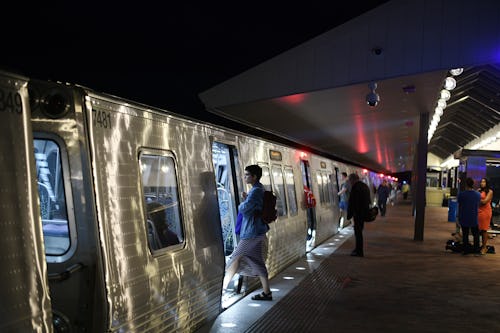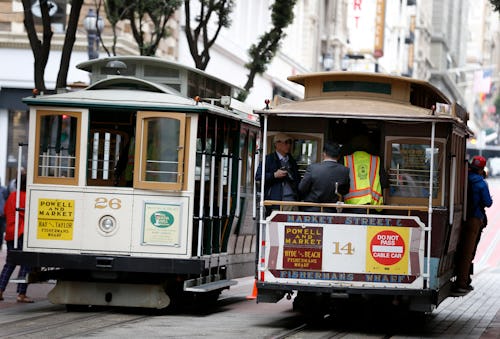
In Olympia, Washington, transit officials went live with a fare-free pilot program on Jan. 1, 2020, shortly before coronavirus would upend life in the United States. A few months before, the city, which has a population of about 53,000, held public hearings about the proposal. If you’ve never been to a municipal public hearing, people typically attend when they’re upset about something. So it took Eric Phillips off guard that so many people attended this meeting to express relief and gratitude for the program.
“It’s remarkable how many people didn’t understand because they don’t use transit, how much of it is subsidized,” says Phillips, the development director of Intercity Transit in Olympia. “Like most of our public infrastructure, [funding for public transit] comes from broader support.”
“Transit is a benefit,” Phillips explains. “If you think about library services or parks, you don’t pay for them in your taxes, and then, when you go, you have to stick a quarter to get through the gate and another quarter to ride on the swing set.” So why do we expect people to pay to board trains and buses when transit is supposed to be funded by the taxes that come out of our paychecks?
Phillips says that once Olympia did implement its fare-free system, the response among riders was overwhelmingly positive and showed that eliminating fares made transit genuinely accessible to everyone. Per the 2020 Census, 82.1% of Olympia’s residents are white, but Black American, Asian-American, and Hispanic or Latinx Americans use public transit at far higher rates than white Americans. “What was overwhelming was the number of people who came in and represented a ‘transit-dependent ridership.’ They were crying and saying, ‘This makes me feel equal.”
Olympia’s fare-free system, which is intended to last five years, is what’s referred to in local government as a demonstration project: a small-scale capital investment intended to “demonstrate” a new approach or system. So far, the program appears to be succeeding — even as mask mandates remain in place for everyone using public transportation.
***
“Every institution, every institution, is absolutely shattered right now,” says Janice Li, a member of Bay Area Rapid Transit’s Board of Directors. Li is part of a scattering of transit experts who are hoping to use the generational tragedy of the pandemic — which made society’s inequities all too clear — to improve the function of, and access to, America’s buses, subways, and trains. “When we think about rebuilding, Rome wasn’t rebuilt overnight,” Li says.
Li is hoping to transform BART, which supported 118 million annual passengers in 2019, into a free transit system. She joins several other transit officials across the U.S. who are looking for ways to make that fantasy into reality. In cities across the country, people are working to develop fare-free transit, which would be supported by funding outside the farebox. These programs make public transit into a public good, like libraries and USPS drop boxes, while also alleviating the unprecedented burden placed on these systems over the last year and a half.
Li likens the concept of free public transit to riding a unicorn: The idea sounds great, but can you promise people they will have the opportunity to saddle up?
“If you think about library services or parks, you don’t pay for them in your taxes, and then, when you go, you have to stick a quarter to get through the gate and another quarter to ride on the swing set.”
Smaller cities, like Kansas City, Missouri, and Corvallis, Oregon, have already implemented universal fare-free programs. In December 2019, Kansas City eliminated the farebox; they lost 8% of their system’s revenue, but riders that would have plugged in money at the farebox wound up spending it on Kansas City’s economy instead. Corvallis made the change in 2011, and it led to a two-thirds ridership increase—an impressive accomplishment, considering the city is sustaining its public transit services through a monthly fee added to residents’ and businesses’ utility bills.
In March, Rep. Ayanna Pressley and Sen. Ed Markey, both Massachusetts Democrats, refiled legislation supporting fare-free transit across the country. Pressley filed her first proposal for free transit last summer. “Our public transit systems are meant to provide communities with the mobility and freedom to access critical services,” Pressley said last June of her ongoing efforts toward equitability in public transportation. She cited a study that shows that Black American bus riders put in 64 more hours of travel time on public transit than white American bus riders—almost three days spent sitting on a bus. Latinx riders also spend ten more hours on the bus on average than white people. Pressley and Markey want to address that disparity with their legislation, called the Freedom to Move Act. They suggest funding fare-free transit through a $5 billion grant program, with the grants intended to offset the revenue lost from cutting fares.
Even with momentum brewing on the federal level, thanks to buy-in from two buzzy politicians, the reality is that for municipalities across the U.S. to get in on the free transit game, they’ll need to educate constituents on the realities of how transit is paid for. Li sees ignorance over subsidization as a marker of class divide. “There’s this conception that public transit is for poor people. Wealthy people simply don’t want to subsidize that,” she says.
Low ridership during the pandemic decimated transit budgets in 2020. Officials scrambling to make up the shortfall made it clear how fickle it is for major transportation systems to rely on individual turnstile transactions to survive. But, for many cities, it also was the ideal condition to try something ambitious.
In Virginia, Alexandria Transit Company (DASH) decided to go fare-free during Covid. Josh Baker, DASH’s general manager, told Mic this spring that DASH’s ridership numbers have since returned to 40% of normal. “That, to me, represents a large portion of people who are transit-dependent, or may not have access to a vehicle or may have limited access to a vehicle,” he explains. “Oftentimes those are the same people who are most hurt by the economic effects of the pandemic.”
The issue is money. Alexandria’s decision to ditch fares during Covid was largely driven by public health concerns. Health officials considered it a “good move,” in Baker’s words, to have people board the bus through the rear doors and avoid interaction with the bus operator—the operator also can’t collect fares when people are boarding from the back. The city was able to forego fare collection thanks to funds provided first by the CARES Act, passed in March 2020, then by the second COVID bill passed in December. “Most of that money, though, is intended for the very, very large systems,” Baker points out, “the New Yorks, the Washingtons, the L.A.s.”

Alexandria has to figure out how to keep its system free without relying on federal funds. “I think if the money’s there ... there wouldn’t be anything that would hold us back from doing it,” Baker says. But he’s keenly aware that funding has to come from somewhere. Only 25% of DASH’s budget comes from fares; proponents of staying fare-free argue that if the city’s already supporting most, if not all, of the remaining 75%, then another 25% on top of that shouldn’t be an issue. Baker agrees with that approach in theory. “You’re still going to have to come up with that money from somewhere, and in our budget, that’s millions.”
So what are the options? Baker says that first and foremost, funding has to be dependable. To that end, “the number one most obvious, most reliable source is for localities to implement dedicated transit revenue in the form of a tax.” Even a one-cent tax could raise enough money to sustain fare-free transit; as long as the taxed goods are always available and always necessary, a tax would be a great candidate to help maintain free transit.
Cities could also access specialized funds for “experimental purposes,” Baker says. These funds would allow cities interested in going fare-free to do so and sustain the system without risk. A gas tax could also work, even if the concept is counterintuitive. But the problem with both of these suggestions is that neither are dependable: Specialized funds aren’t consistent, as Baker notes, and if traffic plummets or gas prices change, a gas tax won’t bring in the same amount of money as it did before. In May, Alexandria’s city council approved the budget for the next fiscal year, and per their efforts, DASH will stay fare-free, possibly thanks to planned capital investments clocking in at $293 million.
Each city interested in going fare-free has to come to that determination on its own, and overhauls of these systems aren’t going to happen immediately. Li describes San Francisco’s approach to changing BART as “incrementalism,” an unsexy way of describing how American institutions can slowly implement new protocols and adapt with time.

As an example, she compares Muni, the San Francisco intracity transit system comprising buses, light rail Metro trains, and the city’s charming cable cars, to BART’s commuter rails. Muni, she tells Mic, has “some of the nation’s most aggressive discount programs,” including free transit for people under 19 and over 65, as well as for people with disabilities. BART’s commuter system is another story entirely: “When you talk about free transit, people at BART say, ‘how the heck are you going to make up those hundreds of millions of dollars that run our system?’” Li says.
That’s why BART going fare-free in the near future feels like a pipe dream. But there’s reason for optimism: For the last year, BART has participated in the Clipper START pilot program, which, per the San Francisco Municipal Transportation Agency (SFMTA), strives for a “consistent fare discount standard for the Bay Area region.”
While discounted fares may not seem like much compared to zero fares, Li sees the development as a good sign. “My hope and dream is that the Clipper card is truly just a start,” Li says. “It’s a discount that we can continue to grow and model ... to the point where we are changing and shifting our revenue stream and rethinking our budget.”
For BART, and for other transportation systems, it’s a “major culture shift” for Americans to begin to view transit as a public good, Li says. Until the last few years, most people have considered buses and trains to be part of a business. But as COVID slowly subsides, it might be time to treat it as a necessity — for public health, wellbeing, and accessibility.







